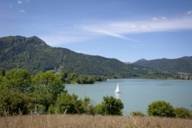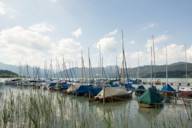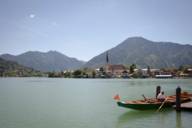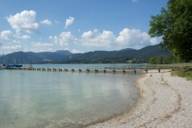
Tegernsee, nestled between hillsides of dark-green forests, is lined with reeds and old oak trees along its banks. Beyond, the masts of sailing boats sway in the wind. In front of the Bräustüberl in Tegernsee, good fortune comes in its own color: yellow. Yellow as in the color of the monastery façade, a cold beer, and the evening sun under which visitors can reflect on a day of adventure.
- History and picturesque places around Lake Tegernsee
- Bathing spots and lidos on Lake Tegernsee
- Cultural and artistic Heritage: Olaf Gulbransson Museum & paper factory
- Local Delights at Tegernsee: natural cheese dairy to brewery
- How to get to Tegernsee from Munich
- Hiking and mountain adventures around Tegernsee
- Guided tours and special experiences
- Wellness and relaxation: lake sauna and sulphur bath
Tegernsee is a natural wonder with origins dating back to the last ice age. The founding of the Tegernsee Benedictine Abbey brought life to the region in the 8th century. Today, the lake is surrounded by the charming communities of Gmund, Bad Wiessee, Kreuth, Rottach-Egern, and Tegernsee. The many rose-covered houses, flowerbeds, and boathouses on the Mangfall River, which flows from the lake near Gmund, create a picture-perfect scene.
Share the view from the jetty at Strandbad Kaltenbrunn (lido) over the panorama of the Tegernsee mountains and Wallberg with a loved one. The valley also features Hirschberg, Riederstein, and Schloss Ringberg. The Tegernseer Valley is the setting for the film "Die Geschichte vom Brandner Kaspar," about a man who cheated death because he couldn't bear to leave his wonderful life. It’s easy to see why, given the stunning region he lives in.
The Strandbad Seeglas (lido) in Gmund is also great for swimming: here you can lie on the lawn, go into the water from the jetty and stop off at the restaurant terrace in the evening. From the Freizeitanlage Point, you not only have a postcard view of Rottach-Egern and its church tower, but you can also take a dip in the shallow water. And the Freibad Abwinkl (outdoor pool) is accessible free of charge and also has a kiosk and a beach volleyball court.
The foothills of the Bavarian Alps, just 50 kilometers from Munich, are home to several prominent figures. From 1929 until his death in 1958, Norwegian painter, illustrator, and caricaturist Olaf Gulbransson lived at Schererhof on the southern slope of Neureuth. There is a museum dedicated to the artist in Tegernsee. In addition to the permanent Gulbransson exhibition in the pavilion, there are also regular special exhibitions in the modern extension. Incidentally, the 1966 pavilion was designed by Sep Ruf, the architect of the Chancellor's Bungalow in Bonn.

The Gmund Papier handmade paper mill is also worth a visit. It has been located here for 190 years - paper has been produced in the Mangfalltal valley ever since. In the meantime, fine paper was also produced here as a supplier to the Bavarian royal court in Munich. To this day, Gmund paper is known worldwide for its high quality and was even used for several years for the envelopes and cards at the Academy Awards. Today, the traditional company works in an environmentally friendly way: up to 75 per cent of the energy required is generated in-house using hydroelectric and solar power. If you would like to find out more about paper production on site, you can visit one of the guided tours. The shop sells high-quality handmade paper products.
A guided tour followed by a stop at the Naturkäserei Tegernseer Land (natural cheese dairy) in Kreuth is also worthwhile. The independent cheese dairy was founded in 2010 by a few local farmers. Today, just a handful of farms supply the dairy with raw milk, the smallest of which has only seven cows. Picture-book Bavaria, just as you would imagine! The raw milk is then processed into cheese, yoghurt and quark on site within twelve hours. Visitors can buy around 20 different types of cheese and other products in the farm shop. Guided tours of the farm are also offered on site, some of which include tastings. If you want to stop for a bite to eat, sit down in the idyllic beer garden.

When you think of Lake Tegernsee, you naturally think of Bavarian beer: the largest local brewery, which has long been known throughout the region, is the Herzoglich Bayerisches Brauhaus Tegernsee. It is located in the north wing of the former Tegernsee monastery, on the eastern shore. Today, for many guests, a visit to the ‘Bräustüberl Tegernsee’ or the ‘Schlosswirtschaft Tegernsee’ is simply a must. Hoppebräu in Waakirchen is the right place for a guided tour with beer tasting: the young brewer Markus explains everything about beer production. Afterwards, you can eat in the restaurant with beer garden - and drink beer, of course!
Train connection: approx. 1 hour to Tegernsee or Gmund. Information at bahn.de
Car: approx. 1 hour via the A8 motorway
A circular bus serves the localities around the lake every half hour. For those who enjoy hiking and walking without extreme Alpine challenges, there are plenty of fantastic trails around Tegernsee. Popular routes include the Tegernseer Höhenweg from Gmund to Tegernsee, the climb to the mountain restaurant on Neureuth, or the Aueralm at the foot of Fockenstein.
You can also reach the 1,722-meter peak of Wallberg, with its 360° views of the Bavarian Alpine foothills, by mountain railway. In 2018, Kreuth officially became a "Mountaineering Village," an award for outstanding sustainable mountain tourism granted by the German Alpine Association to only three other places in the Bavarian Alps. It’s a true delight in summer to hike through the Wolfsschlucht gorge behind Kreuth, enjoying the many pools along the way.

For those who prefer relying on the expertise of a local, certified Tegernseer Heimatführer guides offer various tours. A highlight is the "Night and Stars" walk, an approximately one-hour excursion with stories about the city along the way and opportunities to observe the night sky through astronomers' telescopes. Other attractive offers include forest bathing, geocaching, and a guided tour tracking the golden eagle.
Bad Wiessee, known for its casino, is also a designated spa resort. Mineral springs discovered in 1910, named Adrianus and Queen Wilhemina, are Germany's strongest iodine and sulfur springs. The new Jod-Schwefelbad (iodine and sulfur spa) opened in Bad Wiessee in June 2020, designed by award-winning architect Matteo Thun.
The freshly renovated Seesauna in Tegernsee offers wellness for the body in a unique setting. If sweating isn't your thing, even on a sauna boat, head up on deck on one of the Bayerische Seenschiffahrt pleasure cruisers. There are many landing stages around Tegernsee, including one right on the waterside promenade at the Bräustüberl in Tegernsee, where one could imagine God himself would take a seat if he lived in Bavaria.
More information: www.tegernsee.com